This Quinoa Bread is an easy, yeast-free, gluten-free sandwich bread perfect for adding protein and fiber to your sandwich.
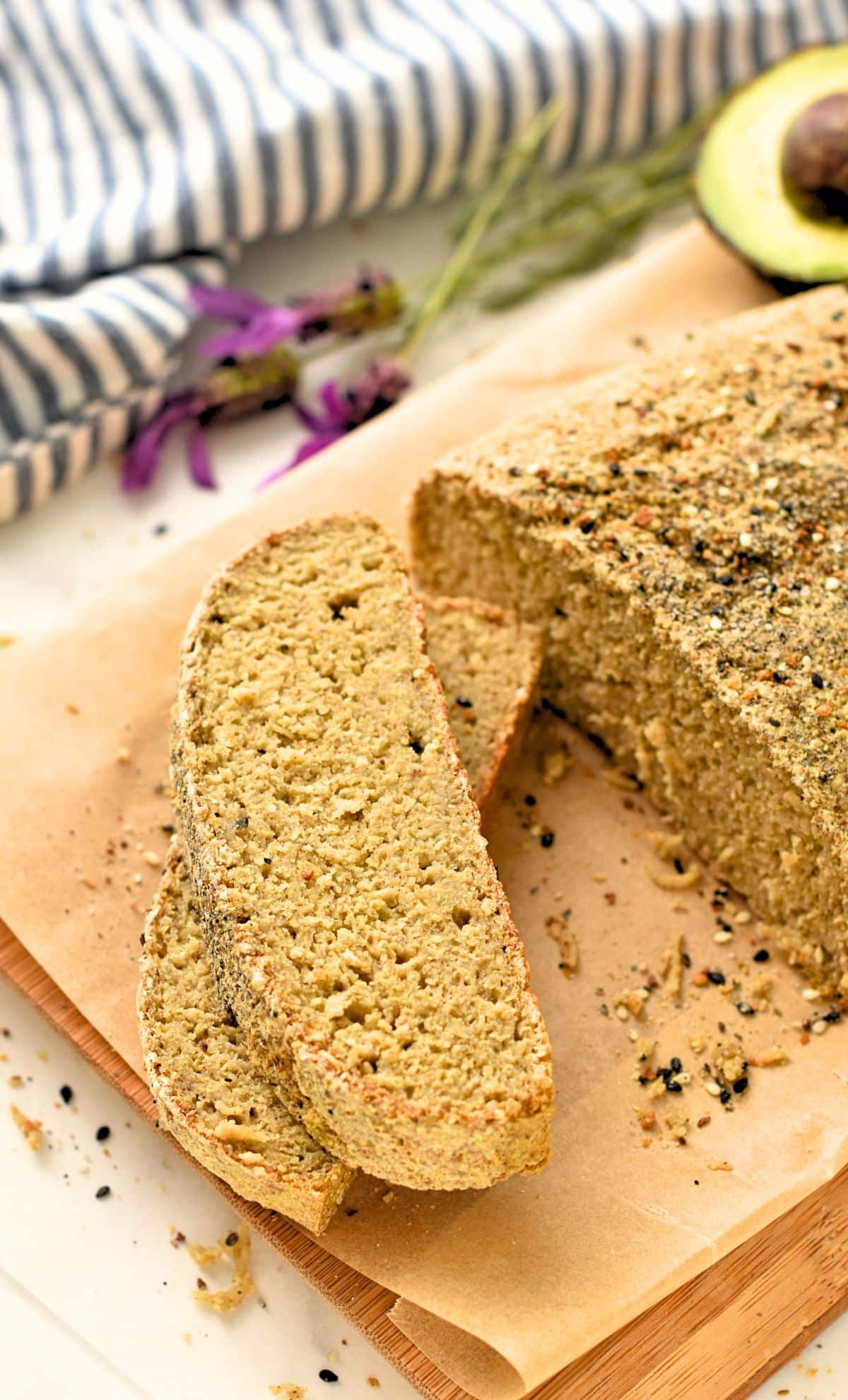
I love making simple and healthy bread, like I did my Millet Bread and Oat Flour Bread but I also love baking with quinoa. So I decided I needed to make a bread loaf with quinoa, a healthy and very nutritious grain.
This bread is super easy to make, with no kneading needed, no yeast. It has a soft crumb, relatively dense, with no bitter taste and it’s easy to make it sweet or savory.
Nutritional Highlights
- Protein and Fiber Boost – Two slices provide 10g of protein and 10g of fiber, keeping you full and helping digestive health. It’s perfect for a high-protein, plant-based diet.
- Wholesome Ingredients – Made without refined flours or protein powders, this bread is a natural, nutrient-dense option.
Ingredients and Substitutions
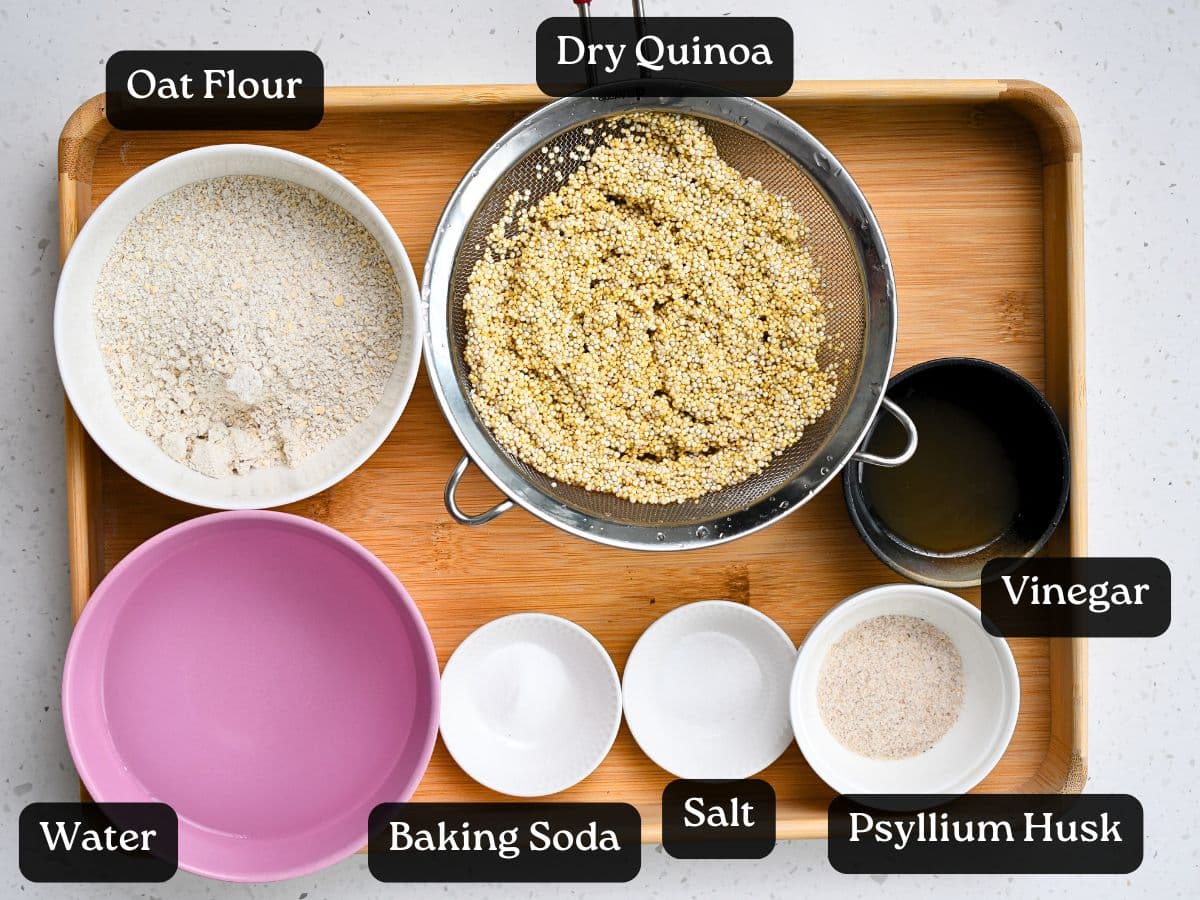
- Quinoa – The base ingredient that provides protein, fiber, and structure to the bread. Soaking raw quinoa softens it for blending and activates its nutrients. Red quinoa works as a substitute for visual variety, but avoid cooked quinoa as it won’t bind properly.
- Oat Flour – Adds body and mild sweetness to the bread while being gluten-free. Use certified gluten-free oats if necessary. You can replace oat flour with sorghum flour or a mix of almond flour and coconut flour, but adjustments to liquid content may be required. Avoid using coarse oats as they won’t blend evenly.
- Psyllium Husk Powder – Acts as a binder and provides chewiness, replacing gluten and eggs. Use 20% more if substituting with psyllium husk flakes. Avoid supplements like Metamucil as they can ruin the texture and cause discoloration.
- Baking Soda – Provides leavening to slightly lift the bread. Make sure to pair it with an acidic ingredient like apple cider vinegar for activation. Baking powder can be used as a substitute, but it won’t provide as much rise.
- Lukewarm Water – Hydrates the ingredients and creates a smooth batter. Avoid cold or boiling water, as the texture will not develop properly.
- Apple Cider Vinegar – Reacts with the baking soda to help the bread rise and adds a subtle tang. Lemon or lime juice can be used as alternatives. Avoid skipping this ingredient, as the bread won’t rise without it.
- Salt – Enhances the overall flavor. Any kind of fine salt works, but don’t use coarse salt as it may leave uneven salty spots in the bread.
How to Make Quinoa Bread
This recipe is super simple to make. Here’s how in pictures.
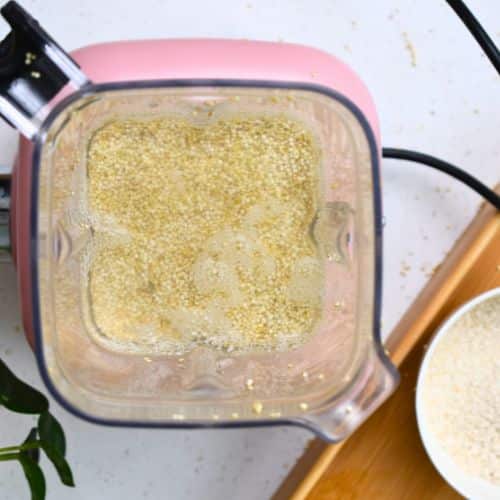
Blend the soaked quinoa in a high-speed blender until smooth.
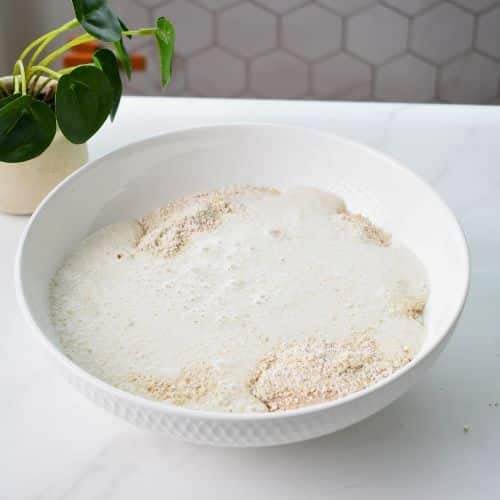
Combine the other bread ingredients in a large mixing bowl.
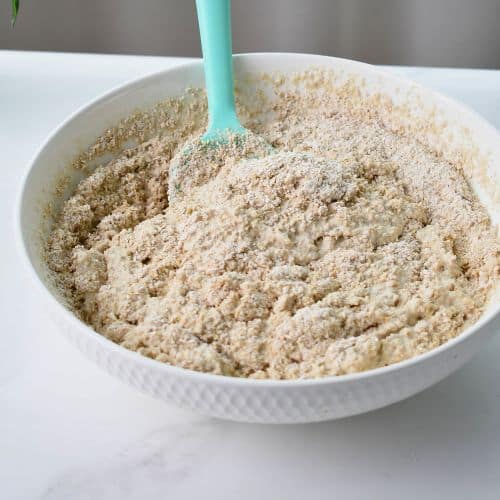
Incorporate the quinoa mixture and the apple cider vinegar.
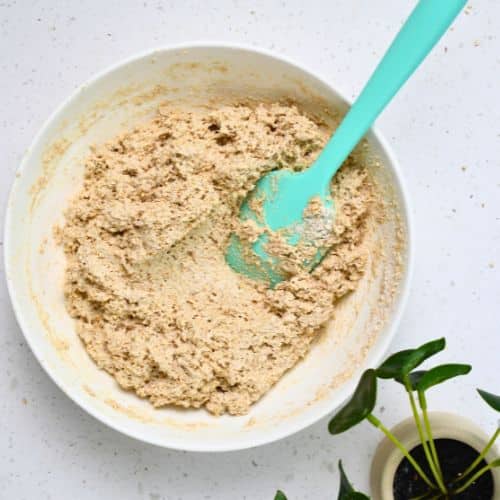
Stir the dough with a silicone spatula until it’s well combined.
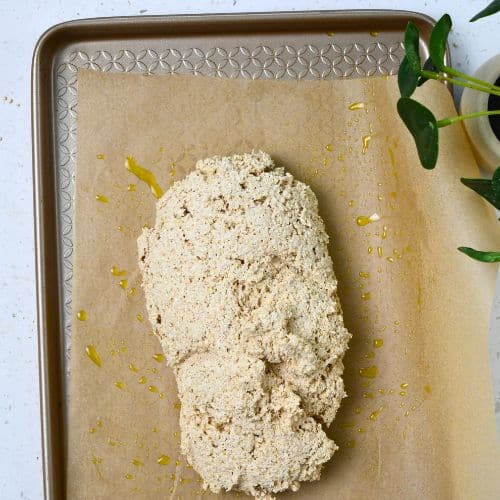
Transfer the batter to a baking pan lined with parchment paper and smoothen and shape the dough into a loaf.
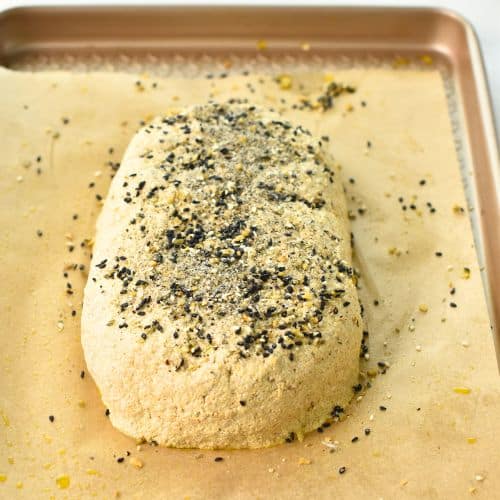
Sprinkle some bagel seasoning and bake the bread for 1 hour at 350 °F (180 °C).
Bread Flavor Options
This recipe is very easy to make sweet or savory by incorporating additional ingredients into the batter.
- Sweet Bread – Add 1 teaspoon of cinnamon to the dry ingredients and 1/2 cup of finely chopped dried fruits like apricot, dried cranberries, or dates.
- Savory – Add 1/2 teaspoon of onion powder or garlic powder and 1 teaspoon of cumin or paprika to the dry ingredients. Stir in 1/2 cup of seeds or chopped sundried tomatoes. I don’t recommend stirring wet grated vegetables into this bread as it won’t bake in the center and stay too moist.
Carine’s Baking Tips
While this recipe is really easy, I have a few more tips for you to make the best bread possible.
- Soak Quinoa Overnight – Soaking not only softens the quinoa but also removes bitter saponins for a better flavor.
- Blend Quinoa Smoothly – Blend until no visible grains remain for a uniform batter. A high-speed blender is ideal.
- Don’t Skip Psyllium Husk – It’s crucial for binding the ingredients. Using substitutes or skipping it will lead to crumbly bread. Don’t use Metamucil!
- Shape the Dough Properly – Since the bread doesn’t rise, shaping it to your desired loaf size and height before baking is essential. Keep it under 2 inches tall for even cooking.
- Test for Doneness – Insert a skewer into the bread; it should come out with some crumbs, not wet batter. If unsure, bake longer to avoid a soggy center.
- Cool Completely Before Slicing – Allow the bread to cool for at least 3 hours to set the structure and avoid crumbling.
- Customize Flavors – Mix sweet or savory add-ins into the dry ingredients. Avoid wet ingredients like grated vegetables, as they make the bread too moist. Add seeds to the batter like 1/2 cup of sunflower seeds or pumpkin seeds to add crunch and healthy fats.
- Use Fine Oat Flour – Coarser flours won’t bind properly, leading to a grainy texture. Make your own by blending rolled oats into a powder.
- Watch for Psyllium Husk Reaction – If your bread turns purple, it’s safe to eat but may need a different brand of psyllium for aesthetic purposes.
- Toast for Extra Crunch – If the bread feels too moist, toasting slices before serving enhances texture and flavor.
Common Issues and Fixes
If you still have issues, I have a few suggestions on what and how to fix common problems.
- Purple/Blue Bread – Some psyllium brands react with baking soda, causing discoloration. Use whole psyllium husk or switch brands. However, if the bread is purple, it doesn’t affect its taste or texture.
- Bread Too Moist – Likely caused by insufficient psyllium or coarse oat flour. Bake longer or toast slices to resolve.
- Cracks While Shaping – If the dough cracks, add a teaspoon of water at a time and knead gently until smooth.
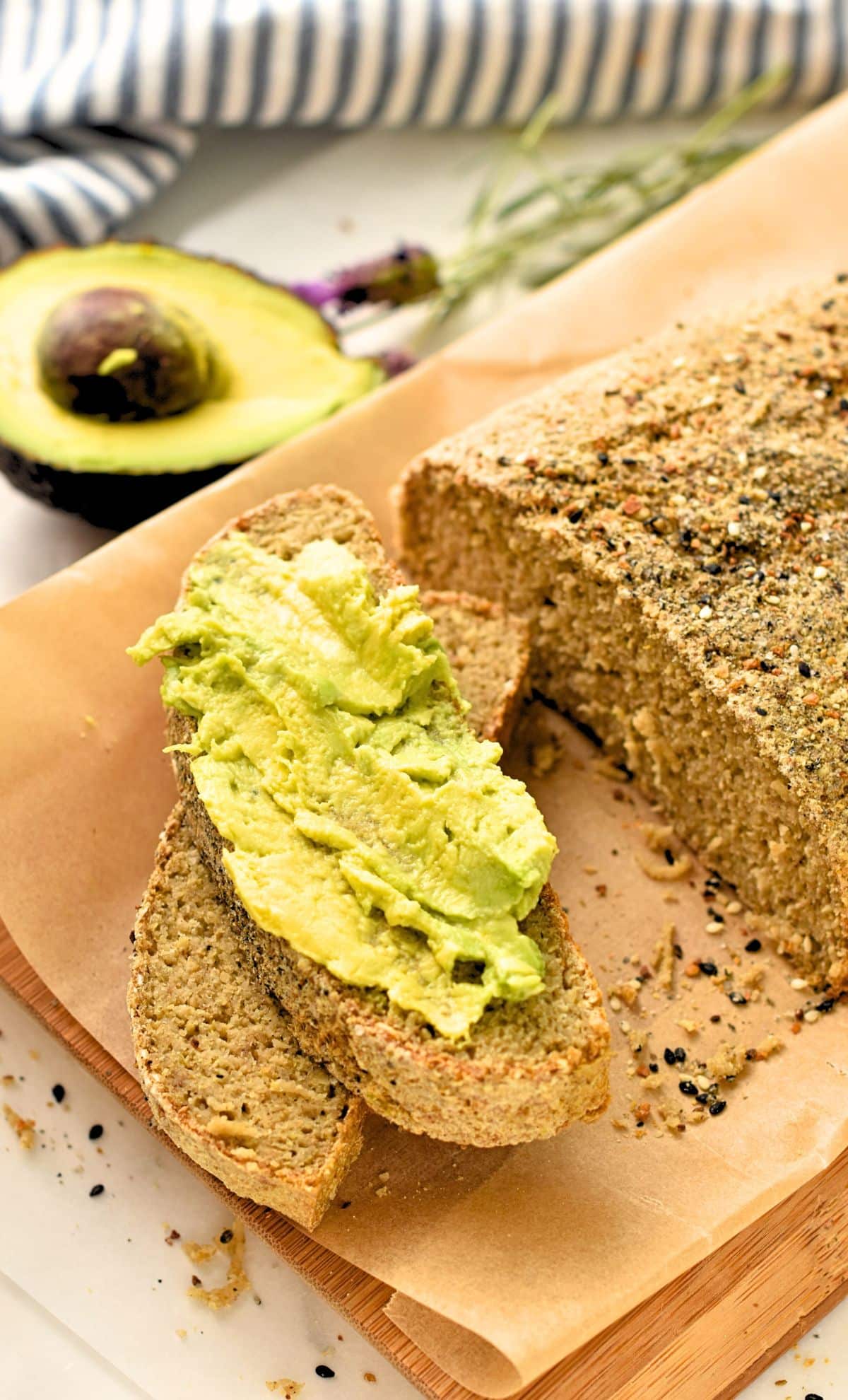
More Bread Recipes
Did You Like This Recipe?
Leave a comment below or head to our Facebook page for tips, our Instagram page for inspiration, our Pinterest for saving recipes, and Flipboard to get all the new ones!
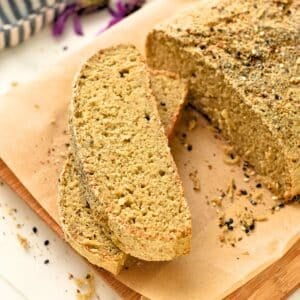
Quinoa Bread
Ingredients
- 1 cup Dry Quinoa - soaked, rinsed, drained (note 1)
- 1 ½ cup Oat Flour - (note 2)
- 3 tablespoons Psyllium Husk Powder - (note 3)
- 1 teaspoon Baking Soda
- 1 ½ cup Lukewarm Water - (note 4)
- 2 tablespoons Apple Cider Vinegar - (note 5)
- 1 teaspoon Salt
Instructions
- Place the dry quinoa in a bowl, cover with cold tap water. Set aside 3 hours or overnight to soak.
- Drain the quinoa over a sieve, give it a quick rinse, then transfer to a high-speed blender with water.
- Blend for 20-30 seconds on medium-high speed until no more quinoa grain can be seen. Stop the blender and set it aside.
- In a mixing bowl, add oat flour, salt, baking soda and psyllium husk powder. Whisk to evenly combine the dry ingredients together.
- Pour the mixture from the blender into the bowl with the dry ingredients and add the apple cider vinegar.
- Use a rubber spatula to stir and combine the ingredients together. As you stir, it forms a thick moist, greyish dough. It takes about 1 minute to form. The time for the husk and oat to absorb the liquid and form a dough.
- Set it aside for 10 minutes.
- Meanwhile, preheat the oven to 350 °F (180 °C). Line a baking sheet with light oiled parchment paper.
- Place the bread dough on the prepared baking sheet. This bread won't raise because it contains no gluten. It won't change in shape or size, so the shape you give now matters.
- Lightly oil your hands and rub around the dough to shape an oval bread that has a maximum height of 2 inches (5 cm). If thicker, it won't bake well in the center and stay moist.
- Sprinkle some bagel seasoning on top of the bread and bake on the center rack of the oven for 1 hour at 350 °F (180 °C). You know the bread is ready when it's hard and crusty on the outside and a pick inserted in the center of the bread comes out with just a bit of sticky batter. It should not be a lot of it and it should not be liquid, just crumbs. If so, it means you didn't add enough husk and need to bake it for longer.
- Let the bread cool down on a cooling rack for 3 hours or overnight before slicing.

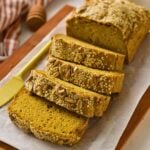
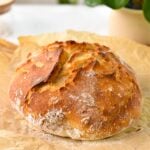
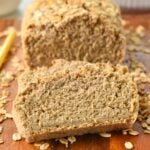
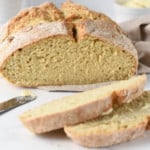


Awesome recipe thank you! One of the best gluten free nutritious easy power breads I have made. Quite soft and moist, toasting it will be perfect
Really enjoyed this and was so easy to make! I will def be making this again and I feel good knowing the ingredients are so healthy!
This bread is so good! Next time I will add a bit more oat flour as I noticed it was too moist in the middle and maybe few more minutes baking time.
Very tasty!
what would change if I used sprouted quinoa flour (commercially made) instead of grinding it myself?
Quinoa flour is not the same as grounded quinoa ratio is so different, I can’t tell how much you will need, it will be a new recipe to develop.
I love this bread! I’ve made it 3 times in the last month. Once with tricolour quinoa, once with white, and once with red (my favourite). I start soaking the quinoa before I’ve finished my current loaf! Such a great texture and delicious taste.
Thank you !!
hi, i made this bread exactly how you said with all the ingredients and the correct amount, and the bread is still moist in the inside and crunchy, brown on the outside. what did I do wrong? I tried this 3 times. thank you
You probably didn’t use the correct husk, some brand are not made for baking and contains only 50% pure husk which means they absorb half the moisture, or your oat flour is too coarse. You can add more oat flour, change husk brand or bake the bread longer. But a good sign is if the bread batter is thick and firm before baking, the bread will be nice.
I love this recipe but I think I may have gotten the amount of water wrong. It states 1.5 cups, which is what I used and it was far too liquid. So I added another cup of flour and poured into two bread pans. Should I be using less than 1.5 cups of water when blending the quinoa?
It can be that your husk is not 100% husk, brand like metamucil have only 50% husk, or your oat flour have a different granulometry impacting the liquid absorption. I do need the 1 and 1/2 cup water as per written in the recipe, but feel free to adapt if it’s not working for you
Just made this today and it was scrumptious!
I subbed ground chia and flax due to being without the psyllium husk powder, and left out the salt until topping with a sprinkle of salt, sunflower and pumpkin seeds. I then baked the rested batter divided into two 4 x 6 x 1-1/2 inch pans for 45 minutes, and left the loaves in the shut off oven the additional 15 minutes.
We were 90% humidity at 70 degrees in South Texas!
I absolutely love this bread! I am so happy to have discovered your recipe. It’s delicious with homemade hummus.
Thank you
Super recette !
Facile à faire et rapide si on pense a tremper le quinoa. Moi je l’ai laissé la nuit pour qu’il y ait une pré germination. Bien rincé.
J’ai cru à la fin que c’était un peu trop liquide alors j’ai rajouté 1 càs de psyllium. Impeccable à former. Cuit en 57 min, facile à découper ce matin et délicieux ! On ne sent pas le goût du quinoa. Merci